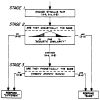Reaction times to comparisons within and across phonetic categories
- PMID: 23226881
- PMCID: PMC3515635
- DOI: 10.3758/bf03213946
Reaction times to comparisons within and across phonetic categories
Abstract
Same-different reaction times (RTs) were obtained to pairs of synthetic speech sounds ranging perceptually from /ba/ through /pa/. Listeners responded "same" if both stimuli in a pair were the same phonetic segments (i.e., /ba/-/ba/ or /pa/-/pa/) or "different" if both stimuli were different phonetic segments (i.e., /ba/-/pa/ or /pa/-/ba/). RT for "same" responses was faster to pairs of acoustically identical stimuli (A-A) than to pairs of acoustically different stimuli (A-a) belonging to the same phonetic category. RT for "different" responses was faster for large acoustic differences across a phonetic boundary than for smaller acoustic differences across a phonetic boundary. The results suggest that acoustic information for stop consonants is available to listeners, although the retrieval of this information in discrimination will depend on the level of processing accessed by the particular information processing task.
Figures




References
-
- Barclay JR. Noncategorical perception of a voiced stop. A replication Perception & Psychophysics. 1972;11:269–273.
-
- Cooper FS, Mattingly IG. Status Report on Speech ResearcH (SR-17/18) Haskins Laboratories; New York: 1969. Computer-controlled PCM system for investigation of dichotic speech perception; pp. 17–21.
-
- Fujisaki H, Kawashima T. Annual Report on Speech Research (SR-17/18) Haskins Laboratories; New York: 1969. Some experiments on speech perception and a mode for the perceptual mechanism; pp. 17–21.
-
- Fujisaki H, Kawashima T. Some experiments on speech perception and a model for the perceptual mechanism. Annual speech mode. In: Hamburg DA, editor. Perception and its disorders, Proceedings of ARNMD. Baltimore: Williams & Wilkins; 1970. pp. 238–254.
-
- Liberman AM, Cooper FS, Shankweiler DS, Studdert-Kennedy M. Perception of the speech code. Psychological Review. 1967;74:431–461. - PubMed
Grants and funding
LinkOut - more resources
Full Text Sources
